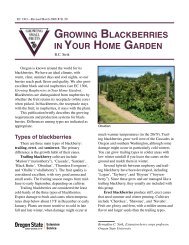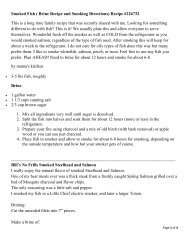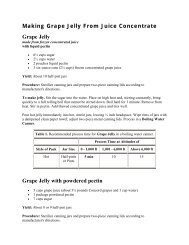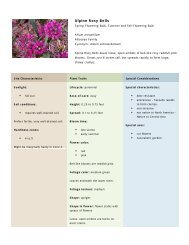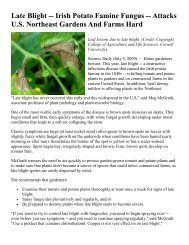Strawberry and Raspberry Pest Management in Wisconsin
Strawberry and Raspberry Pest Management in Wisconsin
Strawberry and Raspberry Pest Management in Wisconsin
Create successful ePaper yourself
Turn your PDF publications into a flip-book with our unique Google optimized e-Paper software.
<strong>Strawberry</strong> Weed <strong>Management</strong><br />
A successful weed management program depends on the <strong>in</strong>tegration<br />
of mechanical <strong>and</strong> chemical methods. Not all weeds that occur <strong>in</strong><br />
strawberry plant<strong>in</strong>gs <strong>in</strong> Wiscons<strong>in</strong> are controllable with herbicides.<br />
Additionally, repeated use of the same herbicide on the same field<br />
grow<strong>in</strong>g the same crop may lead to weed resistance. In these cases<br />
mechanical means such as cultivation, h<strong>and</strong> pull<strong>in</strong>g, <strong>and</strong> hoe<strong>in</strong>g are<br />
necessary. Rotation of strawberries with crops that require different<br />
herbicides <strong>and</strong> cultivation practices should result <strong>in</strong> better weed<br />
management. Weeds cause a multitude of problems <strong>in</strong> strawberry<br />
production, <strong>in</strong>clud<strong>in</strong>g—<br />
• <strong>in</strong>creased cost of irrigation <strong>and</strong> fertilizers due to <strong>in</strong>creased<br />
competition,<br />
• lowered berry yields <strong>and</strong> quality,<br />
• harvest<strong>in</strong>g is more difficult <strong>and</strong> less enjoyable for customers,<br />
• <strong>in</strong>creased difficulty implement<strong>in</strong>g nutrient management <strong>and</strong><br />
<strong>in</strong>tegrated pest management,<br />
• <strong>in</strong>terference with spray applications,<br />
• act as alternate hosts for a variety of diseases, <strong>and</strong><br />
• provide a haven for undesirable <strong>in</strong>sects.<br />
Weeds <strong>and</strong> weed seeds are always present. If no control measures are<br />
taken, the size <strong>and</strong> number of weeds will always <strong>in</strong>crease as the<br />
grow<strong>in</strong>g season progresses. The follow<strong>in</strong>g strategies help to effectively<br />
control weeds:<br />
• Use well-adapted, vigorous cultivars.<br />
• Plant narrower row spac<strong>in</strong>gs <strong>and</strong> adjust plant densities.<br />
• Encourage rapid st<strong>and</strong> establishment.<br />
• Plan shorter crop rotations.<br />
• Use clean, weed-seed-free mulches such as rye straw.<br />
• Always scout for new weeds or “outbreaks” of common weeds <strong>in</strong><br />
your fields. Document them on a map.<br />
• Clean farm equipment between fields (an excellent practice for<br />
<strong>in</strong>sect <strong>and</strong> disease control as well).<br />
• Ma<strong>in</strong>ta<strong>in</strong> good berry crop health.<br />
• Choose the correct herbicide for the situation. Accurately calibrate<br />
the sprayer <strong>and</strong> apply the appropriate labeled rate for the soil type<br />
<strong>and</strong> weed pressure level.<br />
• Mow or treat weeds on the field edge before they go to seed.<br />
Elim<strong>in</strong>ate perennial weeds such as quackgrass, thistles, d<strong>and</strong>elions, <strong>and</strong><br />
dock the year before plant<strong>in</strong>g strawberries by us<strong>in</strong>g smother crops;<br />
summer fallow; non-residual, systemic herbicides; <strong>and</strong> cultivated<br />
agronomic row crops. Rye, for example, is an ideal crop to plant prior to<br />
strawberries. It is sufficiently aggressive to outcompete most weeds but<br />
also has allelopathic effects to suppress emerged <strong>and</strong> germ<strong>in</strong>at<strong>in</strong>g<br />
weeds. Rye used as a w<strong>in</strong>ter mulch is also desirable for strawberry<br />
culture.<br />
25




